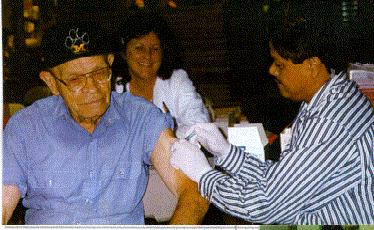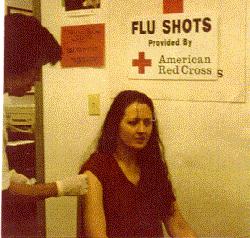Fall is here and so is influenza. When it comes to battling the “bug,” PNAGKC nurses are in the forefront. Armed with needles and vaccine, several volunteers worked alongside the American Red Cross and gave flu shots to clients living in the nearby communities.
 |
| "Don't move!" Ric Anterola cautions his northlander patient. |
 |
| Loreta Concepcion gives Ann Latman her fair share of the "needle" |
Why get vaccinated?
Influenza is a serious disease. It spreads when the influenza viruses pass
from an infected person
to the mouth and throat of a susceptible host. It can cause fever, chills,
cough, sore throat, headache and muscle aches.
Influenza can make people of any age, ill. Although most people are ill only
for a few days, some may have a much more serious illness and may even need
to be hospitalized. Thousands of people die each year from influenza
related illness. Most deaths caused by influenza are in elderly people.
What is the vaccine used this year?
The viruses that cause influenza, change
often. Each year, a new influenza vaccine is made using viruses that are
thought to be most likely to come to the
United States, or ones very similar to them. This year the vaccine contains
these viruses:
A/Johannesburg/82/96 (H1N1)
A/Nanchang/933/95 (H3N2)
B/Harbin/0794
Who should get the vaccine?
Group # 1
People who are at risk for getting a serious case of influenza or a
complication , should get the vaccine.
This includes:
- People 65 years or older
- Residents of long term care facilities with chronic medical conditions
- Any child or adult, including pregnant women, with chronic health problems as heart disease, anemia, diabetes,asthma, kidney and lung disease.
- People who are less likely to fight infection because of: infection with the HIV virus, on long term steroid treatments, and cancer patients on therapy
- Six months to l8 year olds who are on long term aspirin treatment
Health care workers(doctors, nurses, hospital and medical staff, nursing home and chronic care facilities personnel)
Anyone who lives with people the high risk group #1 Group # 3
Students in schools and colleges to prevent outbreaks.
People travelling to the tropics anytime of the year or to countries south of the equator between April and September.
Anyone who wants to reduce the risk of getting the flu.
When should I get the vaccine?
People who need the vaccine should get it every year. The vaccine begins to
protect you after 1-2 weeks
and may last up to one year. Influenza is most common in the US from December
to April, so it is best to
get the vaccine between September and mid-November.
Children less than 9 years old may need a second shot after one month. It can
be given at the same time
as any other vaccines, including pneumococcal vaccine , but in a different
limb.
Can I get influenza even though I get the vaccine?
Yes. Because the viruses change often, they may not always be
covered by the vaccine. However, people who had the vaccine has a milder
case of influenza than those
who did not get the vaccine.
What are the risks from influenza vaccine?
As with any medicines, there are very small risks that serious
problems, even death, could occur after the vaccine. The risk from the
vaccine are much smaller than the risk from the disease if people stopped
taking the vaccine.
Children less than 13 yeras old should be given only split virus to reduce
side effects.
Mild to moderate effects that last 1-2 days after vaccination, includes
soreness, redness or swelling of shot site, fever and aches.
Before giving the influenza vaccine, assess clients if they have:
|
What are the severe reactions and what to do?
Severe allergic reactions include hives, dyspnea, and /or shock.
Get the person to a doctor or hospital right away.
File a Vaccine Adverse Event Reporting System (VAERS) or call them at
1-800-822-7967 to report
incident .
(Source: Centers for Disease Control and Prevention, Phone: 1-800-232-7468 )